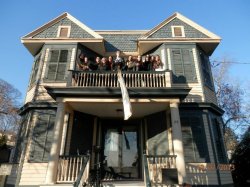Amici Italian Club Explores Local Labor and Immigration History
Posted in: Inserra, Italian News and Events

2013 marked the Centennial of the 1913 Paterson Silk Strike, one of the most well known demonstrations for labor rights in the history of New Jersey given its duration and number of participants. On this occasion, the Amici Italian Club at Montclair State University organized a tour of key locations for the strike that lie a short shuttle ride away from campus. On Dec. 7, a group of students from the Department of Spanish and Italian led by academic adviser Dr. Teresa Fiore (Inserra Chair) visited the American Labor Museum at the Botto House National Landmark in Haledon, as well as the Paterson Museum. Both museums were chosen for their regular and special exhibitions which depict immigrant labor in the early 1900s. The tour placed particular emphasis on the experience of Italian silk factory workers who struggled for better conditions while contributing to the economy of the State.
The six month-long strike involved over 20,000 workers from the silk mills, a thriving industry in the Paterson area since the early-to-mid-1800s, resulting in the town becoming known as the Silk City and as a hub for the development and implementation of industrial machinery. Workers were primarily immigrants from Southern and Eastern Europe with Italians representing one of the most substantial groups. Italy served not only as the origin for much of the labor force, including skilled labor with a tradition of political consciousness, but also for raw materials (a small percentage of the raw silk came from Piedmont/Lombardy in Northern Italy, like many of the immigrants themselves). As Emilia d’Albero, an Italian major and Amici Club treasurer, remarked: “Through the tour I developed a new appreciation for this area – it was incredible to learn that so many technological inventions that we take for granted nowadays originated so close to home.”
Yet, industrial advancement also came at the expense of the workers who worked long hours for subpar wages and were continually exposed to hazards. While the massive factory equipment – so well preserved in the Paterson Museum, where staff member Mohammed Khalil gave students a dynamic and informative tour – reminds us of the golden days of the Paterson area, it is the less tangible and yet equally powerful labor history recorded at the Botto Museum that reveals the resourcefulness and ideological strength of the factory workers. Students learned about Italian immigrants who played crucial roles as leaders of and participants in the strike. After being introduced to the figure of Carlo Tresca (Sulmona, 1879 – New York City, 1943), leader of Industrial Workers of the World (IWW) that fought against long hours, unsafe conditions, and deskilling due to faster looms, they found out about the Bottos, a family that offered their property as a rallying point in Haledon when gatherings were banned in Paterson. Evelyn Hershey, Education Director, shared stories of daily life in the house of these entrepreneurial immigrants from Biella and eventually took students to the balcony from where Tresca and other leaders spoke each in their own language to the international crowd of strikers gathered in the front lawn. Overall, students recognized the workers’ ability to preserve a political conscience across boundaries of ethnicity, gender, and rank while sacrificing themselves through hard work as a pathway towards building a new and successful life for themselves in New Jersey. As Amici Club President and Italian major Cassandra Carollo remarked, “The trip made me aware of the harsh working conditions of those who immigrated to the U.S., especially Italian immigrants in the Paterson, NJ area. I gained a broader and more informed perspective on the stories my grandmother used to share informally about her journey from Italy towards the American Dream.”
Just steps away from Paterson’s fascinating architectural treasures from the industrial era, tour participants literally bumped into the 77-foot high Great Falls that through a system of water raceways once provided power to the mills. A recently designated National Park, the falls are hardly a technology-reminiscent spot today: they instead look like a bucolic corner ideal for a strife-less break!
The program, which according to Dr. Fiore has the potential of being offered once a year to students as well as alumni and donors, was co-sponsored by the Coccia Foundation and the Inserra Chair in Italian and Italian American Studies. It concluded at Palazzone 1960 (Wayne, NJ), where students explored … typical
More information
For comments and photos, see Amici Italian Club on FB and Photo Gallery.
